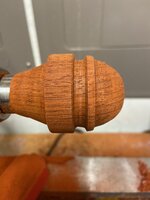Bleedaggie
Member
Brand new turner moving from pens to other projects. I see a bunch of bottle stoppers with far more intricate designs and tighter spaces than this practice blank. But for the life of me I can't figure out how to sand with the grain to get rid of the lines. I've searched the forum and youtube. Confident I'm just not searching the right words because I can't find anything on it and it seems to be something most projects would require. Any help? Thanks in advance.

